Avatar the Last Airbender the Blue Spirit Full Episode
![]()
Bending is the ability to manipulate an element and is significant to many aspects of life in the world. There are five known bending arts; four of them bend a specific physical element while the fifth bends the energy within the human body itself.[1] The only case of any one person being able to bend multiple elements is the Avatar, who has the ability to practice all five bending arts.[2]
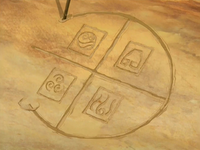
Iroh drew the symbols of the bending arts in the dirt.
The four elemental bending arts are based on the four classical elements, water, earth, fire, and air, each being manipulated through certain martial art styles that are reminiscent of the qualities of the element itself. Bending is traditionally performed through the motions of one's hands and feet, but certain benders are able to effectively manipulate their element with only minimal movement of their body, such as by using just their head or torso. In even rarer cases, benders are able to perform their bending without the aid of any physical movement at all, by instead using sheer focus and force of will, a skill known as psychic bending. Each element is associated with a particular nation in the world; the Water Tribe corresponds with waterbending, the Earth Kingdom with earthbending, the Fire Nation with firebending, and the Air Nomads with airbending. However, other bending affiliated groups exist, such as the Foggy Swamp Tribe for waterbending, the Sun Warriors for firebending, and the Si Wong tribes for earthbending.
The fifth bending art, energybending, is unlike the other four in that little physical action is required to direct the bending itself. The four elemental bending arts are all dependent on the energy, or chi, within the human body, relying on its flow through the body to manipulate a specific element. A person is able to bend when they extend the influence of their chi beyond the body to interact with the environment.[3] Energybending, on the other hand, is concerned with the manipulation of the energy itself and is able to remove or grant bending abilities.[4]
Airbending
- Main article: Airbending

Avatar Aang's native element was air.
Airbending is the bending art used by the Air Nomads; the flying bison were the original airbenders.[5] It concentrates on speed and evasion, forgoing a strong offense for a greater defense. Though apparently lacking fatal finishing moves, it is the most dynamic of all the bending arts. As the element of freedom, airbenders use their capability to bend unencumbered by the ground or any other environmental factors and use their own momentum as a weapon, evading attacks with astounding agility to tire their opponents out or building up massive inertia for explosive gusts of wind to make their counterattacks finishing moves. When resorting to physical confrontation, airbenders are able to harness the immense, intangible power of wind.[6] Airbenders can use a flight technique by operating a glider and using the air to provide thrust and lift. Airbending's opposite is earthbending and the confrontational style that serves as its foundation.[7] The sub-skills of airbending are flight and spiritual projection. Flight has only been achieved by two people in the entire history of airbending, namely Guru Laghima and Zaheer,[8] while spiritual projection is only known to have been achieved by Jinora.[9] Airbending is the element of freedom, and its season is fall.
Waterbending
- Main article: Waterbending
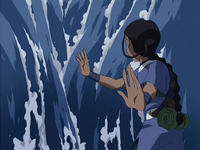
Katara is a waterbending master.
Waterbending is practiced by some people of the Water Tribe. A versatile element, it is unique in the sense that the original bender of the element was not an animal, but rather the Moon.[10] Similar to their element, waterbenders are extremely adaptable and versatile. Waterbending concentrates on the flow of energy, focusing less on strength and more on turning the opponent's own energy against them. While a bender's victory in battle depends on their skill or ingenuity, waterbenders gain a serious advantage or disadvantage depending on the amount of water around them, although highly skilled waterbenders can draw water from anywhere, such as draw humidity from the air and bend the water in living things, especially plants.[11] As the element of change, waterbenders can fluidly and quickly alternate from defense to offense, from a wall of ice to a jet of water, turning their opponent's strength against them. Due to its lunar sympathy, waterbending is stronger at night and ineffective during a lunar eclipse or when the Moon Spirit dies.[12] However, to counter waterbending's ineffectiveness during a lunar eclipse, waterbenders gain immense power during the peak of the full moon. The opposite of waterbending is firebending, with its relatively stagnant, direct philosophy. The sub-skills for waterbending are healing and bloodbending.[11] [13] Waterbending is the element of change, and its season is winter.
Earthbending
- Main article: Earthbending
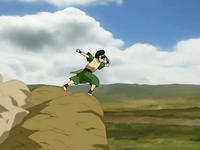
Toph Beifong is one of the greatest earthbenders of her time.
Earthbending originates in the Earth Kingdom and the first earthbenders were badgermoles.[5] It demands a special connection with the earth that is achievable with neutral jing, listening, though seemingly doing nothing and waiting for the right moment to strike.[14] Like waterbenders, earthbenders gain an advantage or disadvantage in battle based on the amount of earth around them, though the conditions are not as extreme. Because of their element's stability and its stress on neutral jing, earthbenders stand their ground, absorbing or intercepting attacks until they completely overwhelm their opponents.[15] Unlike the other bending arts, earthbending's strength equally lies in both offense and defense. Earthbending is in stark contrast to airbending as airbending's emphasis is on evasion and mobility while earthbending's emphasis is on fortitude and strength.[7] The sub-skills for earthbending are seismic sense, metalbending, and lavabending.[16] Earthbending is the element of substance, and its season is spring.
Firebending
- Main article: Firebending
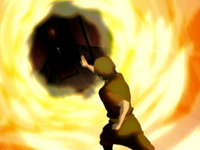
Zuko is a strong firebender.
Firebending is used by the people of the Fire Nation and is the most aggressive bending art. Dragons were the first firebenders; they subsequently taught the Sun Warriors.[5] For a long time, disciplines of firebending were taught to be fueled by hatred, as opposed to the original source. As the element of power, firebenders have to be able to maintain a constant source of energy and balance in battle, unleashing a volley of direct, successive attacks. Unlike other benders who depend on external sources of their elements to bend, firebenders can create fire using their internal heat source in addition to controlling already existent flames. Skilled firebenders are able to fly using powerful jets of flames.[7] Due to its solar affinity, firebending is stronger during the day and at its full power at noon,[10] but completely ineffective during a solar eclipse.[17] When a comet passes close to the planet, the power of a firebender is greatly increased. Firebending's relatively simple and direct style contrasts with the changing style of waterbending. A notable feature of special firebenders is the ability to create a hotter, blue fire; Azula was the only known firebender who demonstrated this extra-powerful flame. The sub-skills for firebending are combustionbending, generating and redirecting lightning. Firebending is the element of power, and its season is summer.
Energybending
- Main article: Energybending
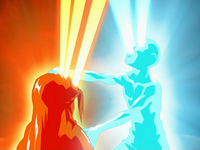
Avatar Aang energybent Ozai to strip him of his bending.
Energybending is the art of bending the energy within one's body. It existed in the era of Raava though was considered a lost art over time. Few Avatars have learned this bending art, and even fewer have used it.[18] It is a highly dangerous technique; if one's own energy is impure and therefore bendable, the practitioner will be consequently destroyed.[4] Energybending allows the user to remove other people's bending abilities,[1] [19] restore them after a bender had their abilities blocked by bloodbending,[20] and used the art to create a spiritual projection.[9]
Inheritance
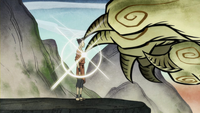
The lion turtle bestowed the power of fire to Wan.
During the era of Raava, people could request a lion turtle to grant them control over an element. As the protectors of mankind, the lion turtles bestowed the ability upon those who planned on traveling through the Spirit Wilds. However, upon their return, they were supposed to return this power to the creature. After Wan became the Avatar by fusing with Raava and closed off the spirit portals at the North and South Poles, the lion turtles declared their roles as protectors of mankind over and stated that they would no longer bestow humans with the power of the elements.[21] [22]
After the departure of the lion turtles, the acquisition of bending abilities became dependent on a large number of factors and complex variables; inheritance patterns are not well understood by the people of the world. Though each nation is affiliated to a specific bending art, not all citizens from any nation, with the exception of the Air Nomads, are born with the ability to bend an element. In the case of mixed marriages, the children may be benders of either element, but never both if they are benders at all; for example, firebender Mako and earthbender Bolin are brothers with parents from the Fire Nation and the Earth Kingdom.
One important known factor in determining the likelihood of a person to inherit bending abilities is the genetic history of the family. It can be considered a recessive gene, since it is possible for a person to inherit bending skills even if they have two nonbending parents, as in the cases of Katara and Toph. Likewise, having one or two bending parents is no guarantee to inherit bending skills; Aang and Katara's eldest son, Bumi, and the swordmaster Piandao were both born nonbenders despite each having two bending parents; though Bumi later acquired airbending abilities following the reopening of the spirit portals.[23]
People who have a greater genetic basis for bending are said to have more "talent", or inherent ability than those who have a weaker genetic basis; though genetics alone do not entirely account for the actual proficiency of a bender, as a person with little genetic basis can become a skilled bender through significantly hard work. On the other hand, it is possible for someone with a strong genetic basis to go about their entire life without ever developing a true ability in bending because of a poor spiritual upbringing or lack of fervor in practice. Due to these anomalies, the nature of bending acquisition fluctuates and has prevented the rise of a superior "bending social class" in the world.
Spirituality is an important aspect of bending inheritance. It is for this reason that all Air Nomads, the most spiritual community in the world, were airbenders. Another notable variable is the population size of the country: for example, the Earth Kingdom is the most populous nation but has the smallest percentage of benders relative to the total population among the four nations. The Earth Kingdom is also the least spiritual nation. Generally, people can determine whether or not they are a bender before reaching puberty.[24]
References
|
See also
- Specialized bending techniques
marshalleired1968.blogspot.com
Source: https://avatar.fandom.com/wiki/Bending_arts
0 Response to "Avatar the Last Airbender the Blue Spirit Full Episode"
Post a Comment